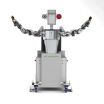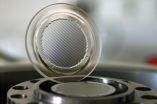Why must we compensate after buying gifts that threaten our identities?
2010-12-23
(Press-News.org) If a vegetarian has to buy a steakhouse gift certificate for a friend, her discomfort will lead her to buy something else that reaffirms her identity, according to a new study in the Journal of Consumer Research.
"When gift givers choose a gift that matches the identity of the recipient but is contrary to their own identity, they experience discomfort," write authors Morgan K. Ward (Southern Methodist University) and Susan M. Broniarczyk (University of Texas). This discomfort leads consumers to choose other products that express their identities.
The authors investigated the consequences for gift-givers when the gifts threaten one of two central identities: school affiliation or political identity. In their studies, the researchers told participants to imagine they were choosing a gift for a recipient who had created a gift registry. In one experiment, gift givers from the University of Texas at Austin (the "Longhorns") chose gifts for a close friend that attended either their own school or the rival school (Texas A&M, home of the "Aggies").
The gifts on the registry were emblazoned with the schools' emblems. "While making a gift choice, the givers of the rival Texas A&M gift were more likely to exhibit physical signs of discomfort such as chewing on their lips, averting their eyes, fidgeting, and crossing their arms," the authors write. At the checkout, Longhorns fans distanced themselves physically from their Aggies purchases.
After they purchased the gifts, Longhorn-identified participants were then offered either an expensive silver pen or a cheap plastic pen with the Longhorn logo on it. Longhorn fans who gave the University of Texas gift were confident in their identities and much more likely to choose the more attractive silver pen for themselves. In contrast, Longhorn fans who purchased the rival Texas A&M gift were more likely to choose the cheap plastic Longhorn pen in order to reestablish their identities.
The authors also found that Democrats asked to choose gifts at odds with their political identities were more likely to choose a subscription to the New York Times, whereas Republicans who chose items emblazoned with donkeys chose the more conservative Wall Street Journal.
###
Morgan K. Ward and Susan M. Broniarczyk. "It's Not Me, It's You: How Gift Giving Creates Giver Identity Threat as a Function of Social Closeness." Journal of Consumer Research: June 2011. Further information: http://ejcr.org.
END
ELSE PRESS RELEASES FROM THIS DATE:
2010-12-23
Picture the following: With great care, a robot picks up a gear wheel in one hand, a housing in the other, and places the two together. When they don't immediately engage, it breaks off its movement. Slowly, it twists the gear wheel round a little and tries again. This time the wheel slots easily into its mounting. The robot smiles, and places the correctly assembled part on the conveyor belt. The pi4-workerbot is capable of making many more movements than a normal robot and is the jewel in the crown of the EU-funded PISA research project, which aims to introduce greater ...
2010-12-23
WASHINGTON, Dec. 22, 2010 — Just in time for New Year's Eve, and the arrival of the International Year of Chemistry, a study may settle that long-standing disagreement over the best way to pour a glass of champagne: Scientists in France are reporting that pouring bubbly in an angled, down-the-side way is best for preserving its taste and fizz.
The study also reports the first scientific evidence confirming the importance of chilling champagne before serving to enhance its taste. They reported in the American Chemical Society's Journal of Agricultural and Food Chemistry. ...
2010-12-23
The AZTI-Tecnalia technological centre, in a project undertaken by the Tecnolat and Llet de Catalunya dairy product companies within the FUTURAL project, has verified that, as an alternative to the traditional heat treatment for decontamination of a number of dairy products, high pressure technology is highly recommendable. In fact, according to a press release from Tecnolat, the results, especially with ready-to-eat fruit products and in the inactivation of moulds and yeasts in other dairy products, "were highly positive and promising".
The research and trials carried ...
2010-12-23
FINDINGS: By determining how corticosteroids act to increase production of red blood cell progenitors, Whitehead Institute researchers have identified a class of drugs that may be beneficial in treating some erythropoietin-resistant anemias. One such anemia is Diamond-Blackfan anemia (DBA), which is frequently treated with corticosteroids, despite their severe side-effects. The identified class of drugs may be able to treat other anemias, including those resulting from trauma, sepsis, malaria, kidney dialysis, and chemotherapy.
RELEVANCE: Some common anemias can be treated ...
2010-12-23
Researchers at Cleveland Clinic's Genomic Medicine Institute have revealed multiple genetic discoveries that may permit easier diagnosis and disease management for Cowden syndrome patients who are predisposed to breast and kidney cancer.
The research, which could allow for earlier discovery of cancerous tumors, is published in the Dec. 22 issue of the Journal of the American Medical Association (JAMA).
Charis Eng, M.D., Ph.D, Chair of the Genomic Medicine Institute at Cleveland Clinic, led the research. It revealed KILLIN as a novel predisposition gene for Cowden ...
2010-12-23
December 21, 2010 — (BRONX, NY) — Two researchers at Albert Einstein College of Medicine of Yeshiva University have found that our 98.6° F (37° C) body temperature strikes a perfect balance: warm enough to ward off fungal infection but not so hot that we need to eat nonstop to maintain our metabolism.
"One of the mysteries about humans and other advanced mammals has been why they are so hot compared with other animals," said study co—author Arturo Casadevall, M.D., Ph.D., professor and chair of microbiology & immunology at Einstein. "This study helps to explain why mammalian ...
2010-12-23
Projectors are getting smaller and smaller. Now that pictures are available in digital format almost everywhere, we need projectors to beam giant photos and films onto walls. Projectors contain lenses that spread the light from the pixelated source in such a way as to illuminate the image area evenly. Until now, this was done using complicated arrays of lenses placed one behind the other. Recently, the same effect has been achieved using flat lens arrays made up of thousands of identical microlenses. This kind of array takes up much less space and does not need to be painstakingly ...
2010-12-23
The only way to learn if your water source has hexavalent chromium is to check with your public water supplier and request a water quality report, said NJIT Professor Taha Marhaba, a civil/environmental engineer. Most municipal or city engineers should be able to provide such a report upon request. Additional information specifically about hexavalent chromium levels may also be available.
"In general, hexavalent chromium can be found in either surface or groundwater sources and its source can be either natural or man-made industrial operations that have used chromium," ...
2010-12-23
About 50 miles from Bethlehem, a drilling project is determining the climate and earthquake activity of the Holy Land. Scientists from eight nations are examining the ground below the Dead Sea, by placing a borehole in this deepest basin in the world. The International Continental Scientific Drilling Program ICDP brings together research teams from Israel, Japan, Norway, Switzerland, the USA and Germany. Particularly noteworthy: Researchers from Jordan and Palestine are also involved.
Scientists and technicians of the GFZ German Research Centre for Geosciences have now ...
2010-12-23
JACKSONVILLE, Fla. — Neuroscientists had assumed that a mutation in the progranulin gene, which makes the progranulin protein and supports brain neurons, was sufficient to produce a kind of dementia known as frontotemporal lobar degeneration (FTLD). But now an international team of scientists led by researchers at Mayo Clinic's campus in Florida have found another genetic factor they say appears to protect against the disorder in progranulin mutation carriers.
In an article published in the Dec. 22, 2010, issue of Neurology, the medical journal of the American Academy ...
LAST 30 PRESS RELEASES:
[Press-News.org] Why must we compensate after buying gifts that threaten our identities?


